THE RELEVANCE OF COUNTRY-OF-ORIGIN EFFECTS ON PERCEIVED QUALITY OF GLOBAL BRANDED PRODUCTS: a study with young Brazilian customers
Braun Fuchs, Chrissie Maximiliane (2013)
Braun Fuchs, Chrissie Maximiliane
2013
Kuvaus
Opinnäytetyö kokotekstinä PDF-muodossa.
Tiivistelmä
Globalization and complex competitive environments has led companies to establish manufacture units in developing countries. Previous studies suggest that products manufactured in developed countries have a more positive image than products made in developing countries. However, researchers have been arguing that Country-of-origin (COO) effects are no longer relevant since young customers became used to see products designed in one country and manufactured in another. Thus, it is relevant to understand how consumers in emerging markets perceive partitioned country-of-origin cues and to which extent they are still influenced by country of origin effects. The present study analyze the perception of young Brazilian customers, in order to understand the joint effect of the Country-of-manufacturing (COM) and Country-of- design (COD) on quality perception of global branded products. Results are based on the analysis of qualitative data collected on 24 semi-structured interviews with young Brazilian customers focusing on global products manufactured in China. Findings suggest that COO effects have an overall low relevance among the interviewees, despite the fact that China as COM seems to still influence negatively product quality evaluation for many respondents. Nevertheless, it was possible to identify two different groups of customers. The first is less affected by COO effects, but more affected by Brand image, Perceived Brand Globalness and apparently more sensitive to cost versus benefit evaluation. The second group was more affected by COO image, but this influence was founded to be mainly mediated by animosity feelings. Other moderators and factors mediating the joint effect of COM and COD on product quality evaluation of global branded products are presented and discussed.
